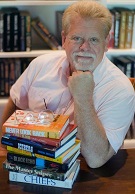Book Collecting – A Literary Adventure, Part 2
John Hutchinson, VJ Books
December 20, 2015

Part Two
Now that you have decided to collect books, it will be helpful to sharpen your eye, so here are a few tips to make you search more successful.
First, let’s divide the subject into two different groupings: 1) book that you want to read, and 2) books that you want to keep. The crossover is obvious – you will usually want to read books that you want to keep in your collection.
Books You Want To Read
Let’s consider for a moment the “books you want to read.” These are usually authors or books that have caught your attention for some reason; they are recommended by a friend or associate, been advertised, have received movie attention, or are just an author that you have always thought about reading. Let’s call these “test reads.” Before adding a new author or title to your collection, you may want to check them out “on the cheap.” Just to be fair, these options are not among our favorites, as they do little to support the author or your independent bookstore. However, when reading an author for the first time you can save money by picking up a used copy, cloth or paperback, from a local bookstore, thrift store, or at the many “friends of the library” sales or locations. Finally, if you have an e-reader (ouch), you can pick up a preview copy from many online sources.
As you move from pleasure reading into collecting it may prove helpful to make a list of target authors, and do a little research. There are many online resources that can assist you in learning more about the author and their bibliography. Start first by visiting an author’s page on the VJ Books website, or you can google their name and then visit their website or Wiki page to get the information needed to create a list of titles.
VJ Books, Wiki and many author sites group titles by series or topic. If you for instance choose to collect books by Clive Cussler, you may want to start with his “Dirk Pitt” series, and then move on to his other titles. If your collecting passion is more topical i.e. books featuring trains, there are three Cussler titles in which trains prove to be significant to the story – Night Probe!, The Chase and The Wrecker.
Once a list of authors and titles has been created you can move into the “books I want to keep” phase.
Books You Want To Keep
Book collecting is a passionate pastime. Nothing is quite as rewarding as making that special “find,” then proudly displaying it on your bookshelf.
Let me begin this section with some things to stay away from.
Many titles are reproduced in book club editions. Some of these, like those from the Doubleday Book Club, are made in a smaller size than publisher edition, typically a couple of inches shorter. However, be careful, because book-club editions made by the Literary Guild and others are full size books, looking almost identical to publisher editions. Book club editions are not usually considered collectible. However, there are some exceptions. You may want to collect book club editions: when the book club is the only or true first appearance of a story or the first hardcover of a title first released as a paperback; if the book club edition has an author signature which is difficult to obtain; as a place holder until the desired edition can be obtained.
Most libraries receive first edition copies of books as they are released. After they have been in the system for awhile these books are sold to the public. They contain all of the typical library markings, stamps and labels identifying them as property of the library. Try to avoid these items unless you can secure a scarce title for a nominal investment.
What to collect then?
The ideal specimen is a mint, likely unread, first edition, first printing, copy of a title. Finding a first printing of a particular title, in collectible condition, is a prevailing challenge for collectors. Commonly used terminology exists within the book selling marketplace, and it is essential for any collector to understand how books are described. Hardcover books and their dust jackets will usually be graded separately, with the dust jacket condition stated last. So a book that is graded F/F, refers to a book in fine condition with a fine dust jacket. A missing dust jacket greatly reduces the value of a book.
VJ Books uses our own grading system that has been adopted by many booksellers. We will discuss book grading later in this series of articles. In the meantime you can learn more about how we grade books by opening the FAQ section at VJBOOKS.COM.
Print runs (the number of first printings produced) can vary a great deal. Major publishers determine the size of a book’s initial print run based on its projected sales and orders received before publication. Initial print runs are commonly stated on a title’s advance reading copy (ARC,) sent to reviewers months before publication. Some periodicals, such as Publisher’s Weekly, also report the number of copies planned by publishers for select titles. Many people collect ARCs (they are considered the true first appearance of a story). VJ Books is the only place that has a section in our store just for ARCs. There are over 1,000 of them listed – just use the “advance copies” button on our homepage to see them.
Finding out the print run for a particular title is only a small part in determining value or collectibility. While the number of books in print has a huge impact on the value of any given title, supply and demand is the ultimate determiner of a book’s collectibility. Often that value does not find its highest level until years later. Digital Fortress, the first book by Dan Brown, went largely unnoticed until his breakout novel, The Da Vinci Code, was released. Prior to The Da Vinci Code dominating the bestseller charts a copy of Digital Fortress could be found for a couple of bucks. That same title now commands upward to $2,000.
This brings us to the issue of relative scarcity. A book’s scarcity often doesn’t have much to do with the number of copies originally printed, but more likely it relates to the number of copies in collectible condition. This is further complicated by the popularity of the author.
A good tip for anyone trying to build value into their collection is – when an author releases what is reported to be the “breakout” book, try to secure good copies of their earlier works. Seldom does an author reach superstar status with their first book, but when they do get noticed; their earlier works appreciate rapidly as fans scramble for them.
Determining what is a “true first” of a book can be a frustrating proposition. Each publisher uses a different convention for designating the printing of each book they produce. In most modern books the publisher code for which printing you are looking at is found on the copyright page (found on the reverse of the main title page), usually consisting of a line of numbers – “the number line.”
A Pocket Guide to the Identification of First Editions, published by Bill McBride, details the methods that over 4,600 different publishers use to identify their first editions. It’s a handy inexpensive guide and fairly easy to use, small and concise and will to fit in your pocket.
Once you have created a list of the books you want in your collection it’s time to start your search. Of course you can start with all the bookstores in your immediate area, but we live in the age of the internet, and you can sit in front of your computer and browse the shelves of booksellers across the globe.
Many sites have been established in the last twenty years where booksellers worldwide can show their inventories. VJ Books was one of the first booksellers to go online, and our website is a good place to visit first. We understand the book collector, and focus on what is important to them. We also maintain a deep stock of early titles by authors you may be looking for.
AbeBooks, established in 1996, one of the first sites of its type, and it is still one of the biggest. Now owned by Amazon, ABE still runs as an independent operation, offering books from thousands of booksellers worldwide.
Alibris, online since 1998, also offers millions of books offered by thousands of booksellers. It is the largest independently-owned book marketplace in the world.
Biblio, founded in 2003 and is also independently owned, and is similar to both ABE and Alibris in how they operate. With over 5,600 booksellers selling on Biblio, they claim to offer the largest selection of books available anywhere – over 100 million titles.
VJ Books complete inventory can be found on all of the sites listed above.
Bookfinder, owned by AbeBooks (Amazon), provides a comprehensive search engine pulling from ABE, Alibris, Biblio and many other major bookselling marketplaces and websites. Bookfinder is a good resource for any book enthusiast. You can compares prices and determine the value of your personal holdings.
Coming next . . .
Anatomy of a Book, Book Genres and Themes, Signatures and Signed Books, Book Condition & Grading
Good reading ~
John Hutchinson




